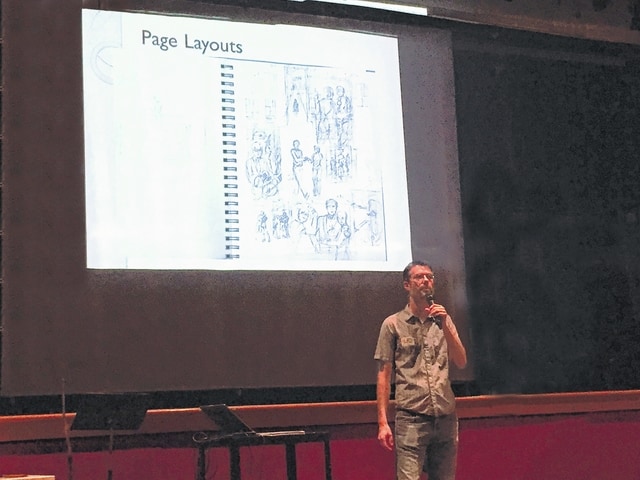
SIDNEY — Local comic artist and writer Brian Latimer recently spoke to Sidney High School art and English students about the process of writing and creating a comic book.
Latimer, who has 13 years of experience in the field, specializes in the penciling and inking phases of the comic creation process. He has collaborated on a number of published works for Assailant Comics, Nathan Sage, Double Barrel Theater, Twilight Star Studios, ComicRelated.com, Red Bud Studios and Airship 27. Latimer is currently working on the creator owned comic, “The Remedy.”
Latimer addressed the process of creating a comic from start to finish, following four main phases – planning, design, production and marketing.
A comic begins with an effective story that is relevant to the audience. Latimer said it begins simply with conceiving the idea. The artist must consider the medium, choose a genre or style (such as American Action, manga, American manga, etc.), and structure the story. The act of writing the story is followed by preliminary research to further study the ideas within the story and formulate the tone. This is then followed by the preliminary design, which includes character sketches, page layouts, and panel placements.
“When I start to do the page layouts and consider the panel placements, I tend to think in terms of cinematography – thinking about things like body language and camera angles,” said Latimer.
He went on to explain the next phase is the design phase, which includes penciling, lettering, inking, and finally coloring. The penciling stage is about the refinement of the drawing. The inking stage, Latimer said, has three colors – white, black, and white. While the black sets the lines and shapes, the white negative space is almost always more important. At this point, the drawing is scanned and sent to be colored using Photoshop. The line layer is separated and the color is blocked. The two are sandwiched together to make the final color drawing.
Latimer shared that the last phase before marketing is the production phase, in which all the preparations are done for the final publication, be it digital or print. This is the final stage of editing. Once the comic is fully produced, marketing comes in a variety of shapes and sizes depending on the project. He shared that blogs and social media have become great avenues for marketing a comic.
Latimer also spoke to the students about what it means to be a professional creative – while creatives are a bit more relaxed and casual, they still have to maintain a high degree of professionalism as they work to meet client demands. He explained the differences of being a freelance artist versus being an employee. He also spoke to the amount of collaboration that goes into the creative professional’s work, especially in the comic industry, adding that as a result of such great collaboration among artists, the initial idea may not be fully realized through to the finished product, and so one must be able to swallow their pride.
Latimer is one of the committee members organizing the Piqua Comic Con, which is set to be held Nov. 14 at the National Guard Amory in Piqua.


